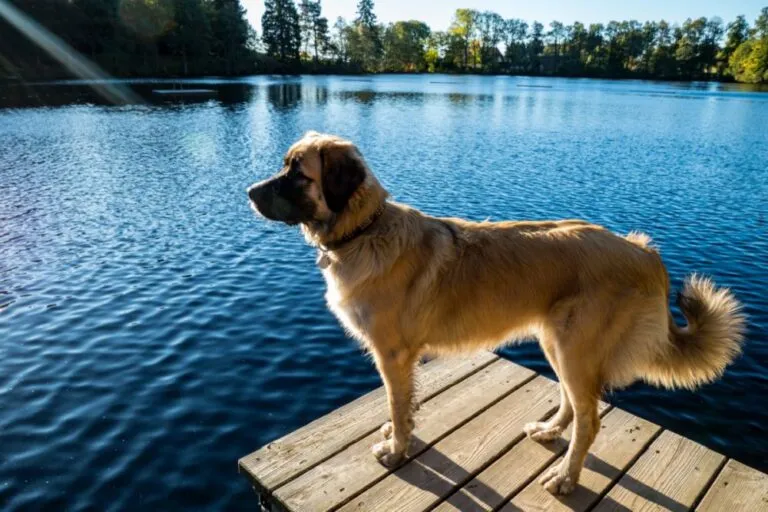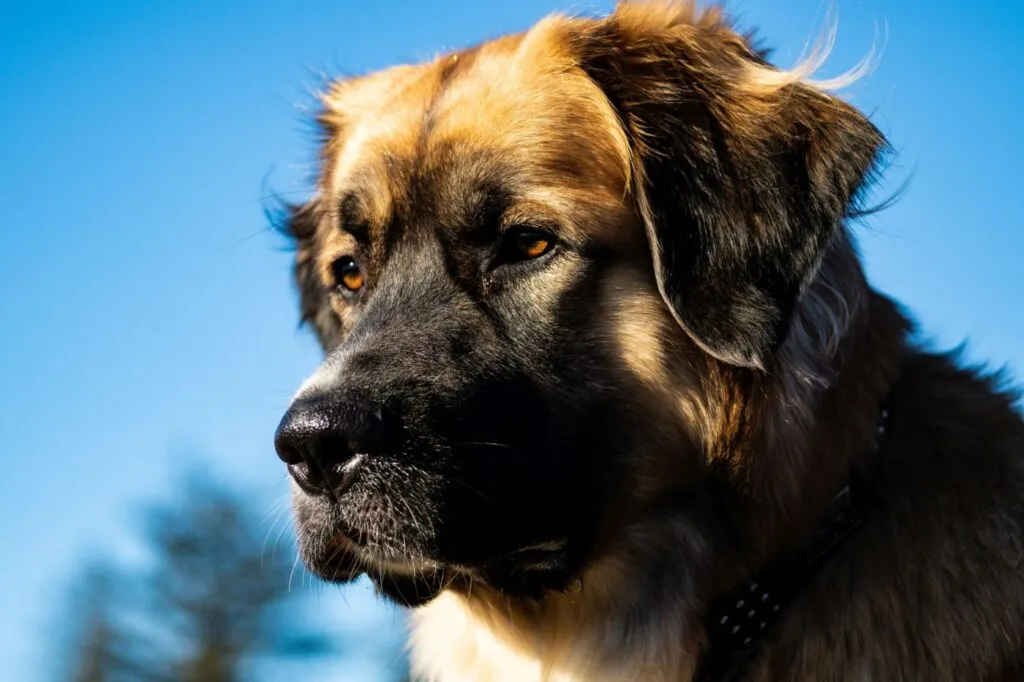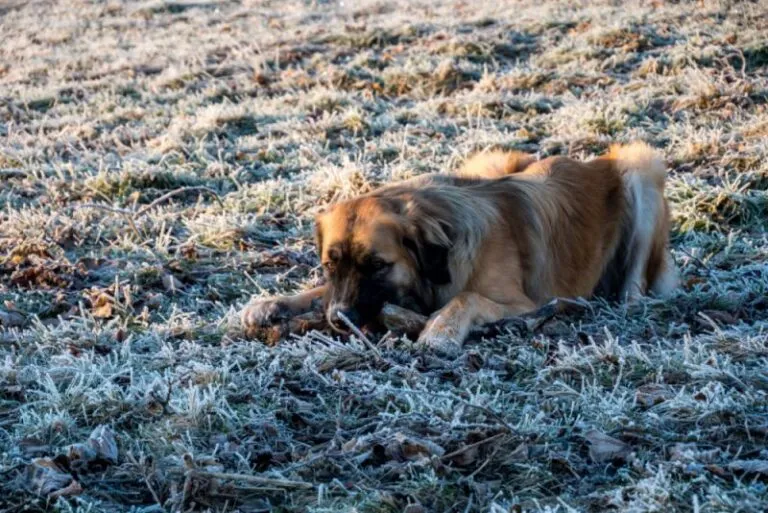Medium Size Poodle
At first glance, the Germanic Bear Dog might seem intimidating. Despite its size, this herding guard dog is affectionate and makes an ideal companion for active families with children. Learn about what a Germanic Bear Dog needs beyond plenty of exercise and engagement in this article.

© ManfredGrandis / stock.adobe.com
Germanic bear dogs are calm companions. Nonetheless, they always keep a close eye on their surroundings.
It’s a dog that looks like a bear – which is why the Germanic Bear Dog truly lives up to its name. Standing up to 85 centimetres at the withers, it easily towers over many other breeds. Bitches are smaller but no less impressive, standing at a minimum height of 65 centimetres.
Similar to a bear, a Germanic Bear Dog is bulky, muscular, and has shaggy fur. Males can weigh up to 85 kilograms, females a somewhat lighter 40 to 70 kilograms. The sheer mass and size of the Germanic Bear Dog can be rather daunting at first sight. However, the impression changes when you get to know this large dog better.
Upon closer inspection, the breed’s benign nature becomes apparent. For example, the broad, square skull with rounded floppy ears ends in a short muzzle, more reminiscent of a teddy bear than a formidable giant.
The almond-shaped eyes have a relaxed to melancholic look. There’s no mention of a wild beast here. Rather, the dog’s beautiful eyes underscore its loving and gentle nature.
The fur of this large breed dog comes in almost all colours. These are typical colours and fur characteristics:
 © ManfredGrandis / stock.adobe.com
© ManfredGrandis / stock.adobe.com
When a Germanic Bear Dog ambles through the living room, coffee cups are likely to rattle. The sometimes ungainly-seeming dog doesn’t always have control of its broad tail and expansive chest. Therefore, it often resembles a clumsy bear.
In interaction, the Germanic Bear Dog is relatively harmless and peaceable. Children quickly realise this and soon lose their fear of the large animal.
As playful and cuddly as it is, the Germanic Bear Dog tolerates a lot before it becomes too much. Once it reaches this point, it usually withdraws discreetly, rather than biting or barking. It also tends to be peaceful towards most other animal housemates.
While representatives of the breed are considered herding guard dogs, the often aggressive, provocative nature of this group is rarely found in most Germanic Bear Dogs. Still, the dog remains vigilant and closely observes its surroundings.
Its defensive protective instinct results in appropriate, lightning-fast reactions whenever it senses danger to its family. It then immediately positions itself between the assailant and the flock to form an insurmountable barrier. It does not tolerate intrusions into its domain but remains remarkably calm. Aggression is shown only in an absolute emergency.
The behaviour of the Germanic Bear Dog greatly depends on its disposition, which can vary widely. Stubborn examples from the breed require a firm hand and much education from puppyhood.
To better gauge the character of your desired pet, you should take a close look at the breeding line when visiting the breeder. Sometimes, fighting dogs or restricted breeds are mixed in, influencing the dog’s behaviour.
Good to Know Due to inconsistent breeding, the dogs’ temperaments can vary greatly. There are simpler and more challenging examples.
The variable nature of the breed manifests itself quite clearly in the hunting instinct: some dogs show no interest in pursuing and catching prey, while others disappear into the forest at every opportunity.
Hence the advice: get to know your dog and tailor the training to its individual qualities.
Not to be underestimated are the size and resulting power of the breed. Even if your four-legged friend is well-trained and obedient: never forget that a dog weighing 80 kilograms is a force of nature. If it pulls uncontrollably on the lead, you will usually lose out.
Obedience and discipline are key to maintaining control at all times. Therefore, place a high value on solid training from the start.
The dense fur of the Germanic Bear Dog is a delight to stroke. To keep it that way, the breed’s coat requires a lot of care. When romping around outdoors and on walks, dirt quickly gets caught in the hair.
Comb or brush the coat with a suitable fur brush preferably daily. If the fur gets heavily soiled with mud, washing is necessary. Afterwards, rub the heavy, wet fur dry with a towel to prevent the dog from catching a chill.
What Does the Ideal Home for a Bear Dog Look Like?
Being outdoors is fantastic for a Germanic Bear Dog. A securely fenced garden with a kennel – and it’s content. Its fur keeps it warm even in harsh weather, and it can keep the best watch over its home and “flock” from outside the door.
Space is particularly important for these dogs. Their size alone prohibits pure apartment living. Additionally, the Bear Dog requires plenty of exercise.
Despite its cumbersome appearance, the Germanic Bear Dog needs to let off steam regularly. Simply tagging along between the football pitch and the kindergarten massively underwhelms the breed. Ideally, offer these dogs a home in a village setting with a large garden and immediate options for extensive walks.
If you choose a Germanic Bear Dog as your animal companion, plan to spend a lot of time with the dog and offer it plenty of activities.
However, take it easy in the early years. Don’t let Bear Dog puppies climb stairs or make jumps and avoid heavy exertion. Only after your vet has given the green light should you consider dog sports.
How Long Does a Germanic Bear Dog Grow? Dogs of this size are sometimes not fully grown until three years of age. Until then, do not strain your four-legged friend’s skeleton and joints excessively.
Germanic Bear Dogs are considered relatively calm dogs that appreciate more leisurely sports. Flyball or Dog Dancing are less suitable for these large dogs. Nose work like Dummy Training or training as a search and rescue dog, however, brings the Germanic Bear Dog much joy.
Perfect for the breed are also gentle endurance sports without spikes in strain:
Hiking with Your Dog, preferably on level terrain rather than in high mountains
The Germanic Bear Dog is not particularly demanding when it comes to its food. It loves fresh meat just as much as high-quality canned foods. When choosing food, ensure it contains as few unnecessary additives as possible.
With large dogs, you should also ensure that your pet takes a rest after its meal time to avoid the dangerous gastric torsion. In summer, ensure your companion has access to a cool spot and avoid exertion during heat.
You’re dealing with a very large and heavy dog in the Germanic Bear Dog, who enjoys moving around. Accordingly, its caloric needs are high.
Compared to other large dogs, you can generally expect double the amount of food. This factor becomes noticeable at the end of the month, as double the food means double the costs.
Thinking about trying [biologically appropriate raw feeding (BARF)]? This method involves pet owners preparing the dog’s food themselves to provide the highest quality.
The Germanic Bear Dog can also benefit from this feeding method. However, BARFing represents additional effort many dog owners shy away from.
Regarding nutrition, it’s especially-important for growing puppies of large breeds to have a balanced composition of food so that the puppy does not gain mass faster than its joints and skeleton can handle.
A Junior Food for Large Breed Dogs supplies young Bear Dogs with essential nutrients. Make sure it has a high meat content.
The breeding of the Germanic Bear Dog is not uniformly regulated. Therefore, it is difficult to assess how puppies of this breed will develop health-wise.
Be especially vigilant when purchasing and closely analyse the breeding lines. This is the only way to get an idea of the potential health problems that could arise in the dog of your choice.
Due to breeding variability, there’s no reliable source or statistics on breed-specific diseases in the Germanic Bear Dog.
However, common sense suggests that the sheer size and weight of the dog could make the musculoskeletal system a weak point. Large dog breeds often suffer from hip or joint problems. Specifically, joint wear arthritis can become prominent with age.
If they maintain stable health, Germanic Bear Dogs typically live up to twelve years. Regular check-ups with your vet should be commonplace at any age.
The historic name of the dog probably has no real historical significance. The breeding of these robust dogs likely began only in 1990. It more aptly summarises the breeding goal: breeders try to approach the Molossers that accompanied the Germanic tribes during their migrations around 1,600 years ago.
Dogs of a similar type were also popular with other peoples such as the Romans, who used the quadrupeds as companions for hunting and herding services. However, the shoulder height of dog skeletons found from the Germanic era is with 62 to 68 centimetres shorter than many modern Bear Dogs.
The extent to which the four-legged companions of the Germanic tribes resemble the modern Germanic Bear Dog is not verifiable.
In 1995, the first breeder’s association Germanic Bear Dogs was established, setting breeding standards. The origin of modern Bear Dog breeding lies in the 1970s and is based on a cross between a St. Bernard and an unspecified white sheepdog.
The first breeder thus attempted to create a new breed. The name “Germanic Bear Dog” certainly has an impact, already suggesting an impressive and primal dog.
The modern standard stipulates that Kangal, Kuvasz, Leonberger, Newfoundland, nor Caucasian dogs are to be crossbred. Unfortunately, the camp of breeders and their breeding lines remain very heterogeneous. Hence, the breed is not officially recognised by the FCI.
 © ManfredGrandis / stock.adobe.com
© ManfredGrandis / stock.adobe.com
If you want to buy a Germanic Bear Dog, you should budget around 1,500 euros for a puppy. Although you might find cheaper offers, be aware that you may need to compromise on breeding quality. If necessary, get information directly from the Germanic Bear Dogs association about reputable breeders.
The Germanic Bear Dog is more peaceful than its imposing appearance suggests. Nevertheless, it is a special dog and a purchase should be well considered.
The following checklist can help you decide:
If you answered “No” to any of the questions, the Germanic Bear Dog might not be the best choice for you. In all other cases, with this breed, you bring into your home a loyal, good-natured, and visually impressive companion.
| Brief Info: | Intelligent herding guard dog of enormous size without FCI recognition |
| Wither Height: | Male: 75-85 cm; Females: 65-80 cm |
| Weight: | Male: 50-85 kg, Females: 40-70 kg |
| Average Life Expectancy: | 10-12 years |
| Price: | 1,300-2,500 € |
| Temperament: | calm, affectionate with children, vigilant |
| Coat: | medium to long |
| Coat Colour: | all, but not pure white or black |
| Training Effort: | medium |
| Grooming Effort: | medium |
| Exercise Needs: | high |
| Origin: | Germany |
| Demands: | medium |
Here are some purchase proposals curated by the zooplus editorial team
The products featured have been carefully selected by our editorial staff and are available at the zooplus online pet shop. The selection does not constitute advertising for the mentioned brands.
Fans of the Bearded Collie agree that those who aren't familiar with this dog breed simply have to get acquainted with it. And those who have experienced how a Bearded Collie bolts across meadows with its flowing fur, how it rolls around full of energy and joy and how it attentively and observantly takes into account its owners wishes become simply addicted to this original dog breed and its unique charm.
The Goldendoodle isn't a breed, but a pairing between Golden Retrievers and Medium or Standard Poodles. Marketed as a low-maintenance dog for allergy sufferers, this hybrid is enjoying increasing popularity amongst dog lovers, similar to the Labradoodle.